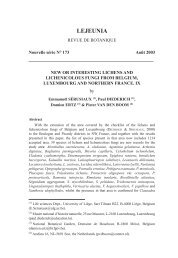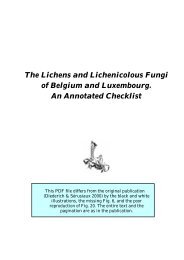A Synopsis of the Genera Skyttea, Llimoniella and - Lichens of ...
A Synopsis of the Genera Skyttea, Llimoniella and - Lichens of ...
A Synopsis of the Genera Skyttea, Llimoniella and - Lichens of ...
Create successful ePaper yourself
Turn your PDF publications into a flip-book with our unique Google optimized e-Paper software.
462 THE LICHENOLOGIST Vol. 32<br />
4(2) Ascomata, when mature, deeply cruciate; margin divided by 3 or 4<br />
deep fissures, almost completely covering <strong>the</strong> disc, except when<br />
old; ascospores 9-12(-13) x 3—4(—4-5) (im; on Lecidea fuscoatra<br />
R. fuscoatrae<br />
Ascomatal margin, when old, not deeply fissured; ascospores<br />
7-10 x 3-4 um; on Porpidia R. makarovae<br />
5(1) Ascomatal margin with hairs (Figs 1A, 14 p. p.) (in R. cruciatus only<br />
visible in microscopical section) 6<br />
Ascomatal margin without hairs (Fig. 14p.p.) 8<br />
6(5) Ascospores narrowly ellipsoid to fusiform, 10-15 x 2-3-5 (im;<br />
ascomata with or without hairs; on Pertusaria panyrga (Fig. 14)<br />
R. pertusariae<br />
Ascospores ellipsoid, mostly under 9 urn 7<br />
7(6) Exciple entirely covered by hairs; ascomatal margin usually without,<br />
or with inconspicuous fissures; ascospores 5-5-9 x 2-5-3-2 um;<br />
green pigment present in <strong>the</strong> epihymenium <strong>and</strong> <strong>the</strong> upper exciple;<br />
on Lepraria lobificans <strong>and</strong> Lepraria sp R. pubescens<br />
Hairs restricted to <strong>the</strong> excipular margin; ascomatal margin <strong>of</strong>ten<br />
divided by a few deep fissures; ascospores 7-8-5(-10-5) x (2-5-) 3-<br />
3-5 jxm; green pigment only present in <strong>the</strong> epihymenium, exciple<br />
entirely brown; on Diploicia canescens R. cruciatus<br />
8(5) Ascospores 15-17(-20) x 2-5-3 um; on Stereocaulon<br />
R. stereocaulorum<br />
Ascospores shorter 9<br />
9(8) Ascomata deeply cruciate; margin divided by 3 or 4 deep fissures,<br />
almost completely covering <strong>the</strong> disc, except when old; ascospores<br />
9-12 (-13) x 3-4 (-4-5) um; on Lecidea fuscoatra<br />
R. fuscoatrae<br />
Ascomata not cruciate, margin not, or not deeply fissured. ... 10<br />
10(9) Ascospores 10-15 x 2-3-5 um (Fig. 14); on Pertusaria panyrga . . .<br />
Ascospores shorter<br />
R. pertusariae<br />
11<br />
11(10) Ascomata partly immersed when young, soon superficial; ascospores<br />
(8-)9-ll(-14) x 2-3(-3-5) urn; asci 35-45 x 6-5-8 um; on <strong>the</strong><br />
Lepraria neglecta-group R. neglectus<br />
Ascomata immersed, almost peri<strong>the</strong>cioid when young (Fig. 13),<br />
later erumpent to superficial; ascospores 7-10 x 3-4 um; asci<br />
47-57 x 6-8 um; on Porpidia R. makarovae<br />
Rhymbocarpus boomii Etayo & Diederich sp. nov.<br />
A Rhymbocarpo geographici ascosporis parvioribus, 8-10.5 x 3-4 pm differt.<br />
Typus: Spain, Mallorca, between Cala D'Or <strong>and</strong> Porto Colom, Cala Arsenau (Cala Sanau)<br />
coastal area, 20 m, on Juniperus phoenicea, mixed with Pinus halepensis, Pistacia <strong>and</strong> Oka, on Dirina<br />
ceratoniae, 3 April 1997, van den Boom 18478 (MA-Lich—holotypus; hb. Etayo—isotypus).





